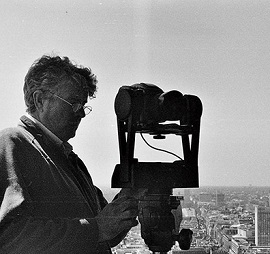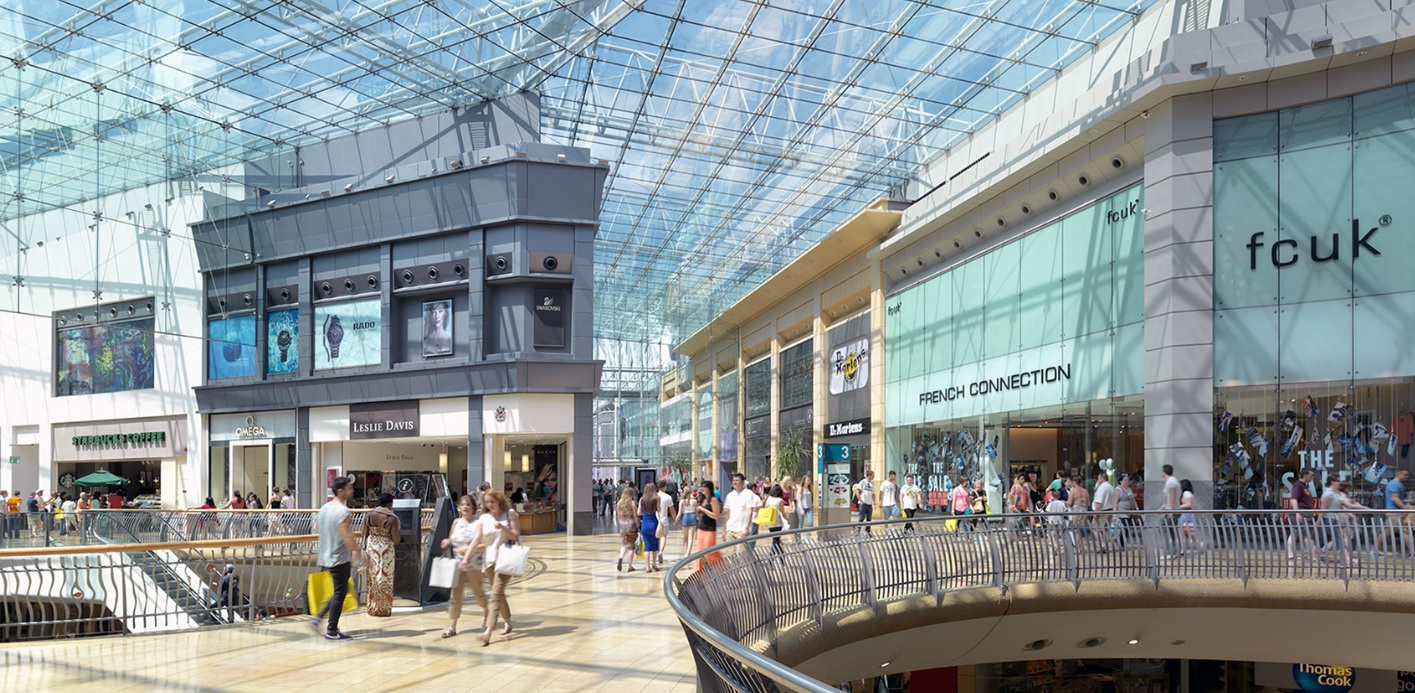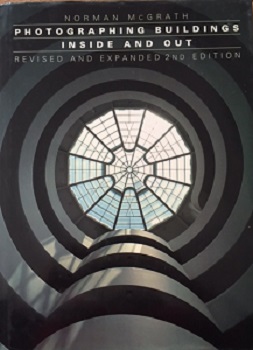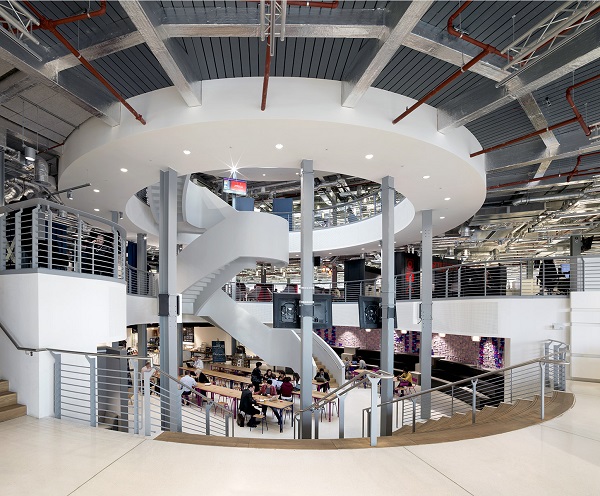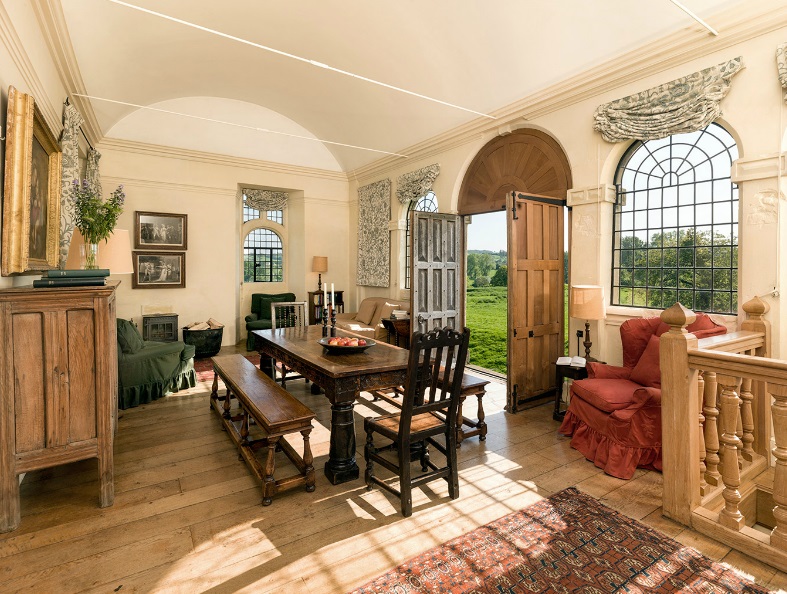Main author
Michael BrooksInterview with Paul Grundy - Architectural Photographer
For more information, see Architectural photography.
Paul Grundy is an architectural photographer based in London. He works on commercial, cultural, historical, and residential projects for a wide range of creative design agencies, property companies and architectural practices. Some of his recent clients include The Royal Mail, The British Library, Channel 4, Crest Nicholson, Land Securities, Toshiba, and Knight Frank.
Designing Buildings Wiki met with Paul to talk about what being an architectural photographer is all about.
(City of London for Almacantar)
| Designing Buildings Wiki: How did you get started in photography? |
Paul Grundy:
I went to art school at 16 to study sculpture and was there for 5 years. In those days, there were only a couple of places where could you study photography as an art as opposed to a craft. When I came out at 21 though there weren't many opportunities for a sculptor in Manchester, so to do something a bit more relevant I picked up photography and ran with that.
I was an amateur for about 6 years, earning my living as a pipe-fitter. I spent a year in Brazil then got in with a picture library and started shooting all the tourist things in London. There was a great guy there who said to me “unless you're going to take the best picture ever of Big Ben, why bother, there's million pictures of it already”.
(The Bull Ring for Hammerson)
| DBW: Do you have a particular photographer who inspired you? |
PG:
All the photographers I liked had nothing to do with architecture. There was a great book by an American photographer Norman McGrath, on how to light interiors - 'Photographing Buildings: Inside and Out'. It was the first time I'd seen anyone explaining this properly, which was such an important insight.
In a way, the architectural photographers in the 1980s were all trying to do exactly the same thing as each other – the same film stocks, shutter speeds, apertures. I began by trying to learn how to take a photograph like the ones in the Architects Journal, but when you get to that point, you think 'this is kinda boring'!
The first time I saw the Bull Ring, I walked round all the different parts of it and got to a point where I thought 'this is where I'd shoot it from'. I looked down and there was a lens cap from a professional camera right between my feet! It proved there were certain rules everyone in the business seemed to be following.
| DBW: So is it not strictly necessary to have architectural training? |
PG:
There are a lot of architectural photographers who trained in architecture, and some see that as a plus, but I think if you can't look at a building and see what it's about, through common sense, there's something wrong.
(BBC Worldwide for HOK)
| DBW: What are the main challenges you face as an architectural photographer? |
PG:
The endless problems with timing. I'd say 80% of my work is from developers, and there's always this need for the photographs just before the building's finished, which is when things like all the windows are filthy. Photoshop can help with some things but not really with problems like that. Working with the weather is also a big challenge.
| DBW: Is it important for a photographer to know the programme of work in order to capture the important stages such as topping out? |
PG:
It varies from client to client. Often with things like topping out, it's a PR story and it's better to have a PR photographer rather than an architectural photographer.
| DBW: Do you find it more challenging/time-consuming to shoot interiors or exteriors? |
PG:
Interiors are easier once you know what you're doing, you're in control of everything. With exteriors, there are things you know will happen; for example, you know the light will hit the middle of a square at a certain time of day or year.
In terms of general competence, I think everyone having such sophisticated technology on their iPhones is brilliant, but the whole secret of being a photographer is to be one step ahead of them. The iPhone is great technically but it hasn't got a brain. I've always thought that to be commissioned, to have people pay for your work, you have to come up with more than just a correctly exposed photograph, so it's not enough just to be technically competent.
| DBW: What's your favourite piece of equipment to work with? |
PG:
I use a Hasselblad, their lenses are just to die for. People will argue that you don't need medium format, but when you look at the images and the colours and sharpness that comes out, nothing really compares.
| DBW: To what extent do you research or investigate a building prior to shooting it? |
PG:
Often I go on the morning of the shoot and spend half a day walking around the place. Whether you meet with the designer or a graphic designer whose putting together a brochure, it's great just to hear what they have to say about it.
Often architects give you lots of plans with little eyes where they want shots taken from. I think my job is to understand what they want but to do something better. What happens a lot these days is that architects live with the CGIs for a long time and that becomes the building in their minds, it's only natural that it does.
You do get requests to replicate the CGI, and that's understandable and not a big issue as long as the CGIs are done from a viewpoint that's accessible. These days CGIs can be so good, apart from the people in them. So photographs are trying to look more like CGI and CGI is trying to look more like photographs.
(East Banqueting House, Chipping Campden for The Landmark Trust)
| DBW: With CAD imaging, BIM and virtual reality all becoming increasingly prevalent as modes of visualising buildings, do you have any concerns for the future of the architectural photographer? |
PG:
I did a 360 off the roof of Centrepoint recently, over 24 hours and technically it was very tricky because it had to be shot from 12 different points. They were talking about making it into virtual reality, but I thought it was just too good an image. I don't think virtual reality can compete, yet at least, with a really good photographic image. But I'm coming to an age where if people tell me 'the future is virtual reality', well, then fine.
It's difficult to get people to engage in these things, no matter how clever they are, because people are surrounded by it all the time. You're never going to really match what Hollywood puts into a film with your apartment 360 or hoarding images outside a construction site.
| DBW: What's the most significant change or development you've seen in architectural photography during your career? |
PG:
Digital definitely. It's just a massive change in every way. My lifestyle has changed, from dropping my film off in a lab in Fulham, an hour later the test prints would arrive on a bike, and then going to collect the film. It was time-consuming but it was also brilliantly sociable.
If you went near that lab on a Friday, you were out for lunch with maybe half a dozen other photographers all afternoon. There'd be photographers who'd shot still-lifes for Harrods, or ski clothes from up in the Alps. I remember there was a travel photographer who used to come in and sit there quaking as 2 months-worth of hotel shots were being processed! So it was a real mix of people who never felt any real competition with one another, and you don't get that same sort of sociability any more. Far more of my time is spent in front of a computer screen editing.
| DBW: Do you have a favourite commission that you have done in the past? |
PG:
In a really egotistical way it would probably be doing the stamps for the London Olympic Games. They weren't hard to shoot but being chosen for that job was really amazing. None of my friends or family cared about what I did for a living until I shot the stamps and then they were all very impressed! It was the fact that the Royal Mail is such an iconic brand, and the Olympics as well.
I'm doing a job in May for HOK which is The Francis Crick Institute, the largest research centre in Europe, by King's Cross. That's a brilliant commission to get because it's an amazing building; I'm shooting it for the 5 main contributors, and probably some of the subcontractors as well.
| DBW: Will you take bespoke photographs for each of them or will they all use the same batch? |
PG:
A bit of both. The main companies involved, the architects and builders, they will have access to all the shots and can divide it up how they want. The subcontractors may want things shot in a way that highlights their work, so there'll be separate shots taken as well. It's a really exciting job to be doing.
| DBW: What advice would you give someone looking to pursue a career in architectural photography today? |
PG:
The thing I really notice now is that because people pay a fortune for their education, colleges have had a tendency to make all kinds of promises to photography students. A steady number get in touch with me and I read the prospectuses of these places, and they say something to the effect of 'do our course, give us all this money, and you will come out a professional architectural photographer, able to accept briefs, etc.', and kids believe it.
If you're really lucky you might get a job as an assistant, but it's getting harder and harder. When I started out I couldn't walk down the street with all my gear, so you needed an assistant just from a practical angle. Now I can pretty much carry my camera equipment in my pocket, and there's a massive amount of time spent in front of a computer, which no assistant really wants to do.
The first time you meet a client might be on the shoot, and sometimes students struggle to see things from their point of view at that stage. For a day, a week, or however long, you work for that client, and fundamentally you are on their side, their concerns have got to be yours, otherwise they're not going to use you. You have to listen to them and what they say. It isn't good enough to think 'I'm a great photographer, let me do it my way', that's not what works. A lot of young people assume the secret is to be a wonderful, individual photographer and that people will flock to them. Sadly, it's not like that.
I read a while ago that it takes 10 years of hard work, regardless of what you shoot, to become a professional photographer – where you can secure an income, pay your mortgage, etc. That was about right for me, and I've watched 2 assistants of mine take that long. So the main thing is to have patience, which I think is increasingly hard to exercise when you've paid all that money and been made all those promises.
All photographs copyright Paul Grundy.
You can see more of Paul's work here.
[edit] Find out more
[edit] Related articles on Designing Buildings Wiki
- Anthony Weller - Architectural photographer.
- Architectural photography.
- Computer aided design CAD.
- Concept design.
- Grant Smith - Architectural photographer.
- How to commission architectural photography.
- Photographing buildings.
- Samples and mock-ups.
- Simon Kennedy - Architectural Photographer.
- TruVision.
Featured articles and news
RTPI leader to become new CIOB Chief Executive Officer
Dr Victoria Hills MRTPI, FICE to take over after Caroline Gumble’s departure.
Social and affordable housing, a long term plan for delivery
The “Delivering a Decade of Renewal for Social and Affordable Housing” strategy sets out future path.
A change to adoptive architecture
Effects of global weather warming on architectural detailing, material choice and human interaction.
The proposed publicly owned and backed subsidiary of Homes England, to facilitate new homes.
How big is the problem and what can we do to mitigate the effects?
Overheating guidance and tools for building designers
A number of cool guides to help with the heat.
The UK's Modern Industrial Strategy: A 10 year plan
Previous consultation criticism, current key elements and general support with some persisting reservations.
Building Safety Regulator reforms
New roles, new staff and a new fast track service pave the way for a single construction regulator.
Architectural Technologist CPDs and Communications
CIAT CPD… and how you can do it!
Cooling centres and cool spaces
Managing extreme heat in cities by directing the public to places for heat stress relief and water sources.
Winter gardens: A brief history and warm variations
Extending the season with glass in different forms and terms.
Restoring Great Yarmouth's Winter Gardens
Transforming one of the least sustainable constructions imaginable.
Construction Skills Mission Board launch sector drive
Newly formed government and industry collaboration set strategy for recruiting an additional 100,000 construction workers a year.
New Architects Code comes into effect in September 2025
ARB Architects Code of Conduct and Practice available with ongoing consultation regarding guidance.
Welsh Skills Body (Medr) launches ambitious plan
The new skills body brings together funding and regulation of tertiary education and research for the devolved nation.
Paul Gandy FCIOB announced as next CIOB President
Former Tilbury Douglas CEO takes helm.
UK Infrastructure: A 10 Year Strategy. In brief with reactions
With the National Infrastructure and Service Transformation Authority (NISTA).







